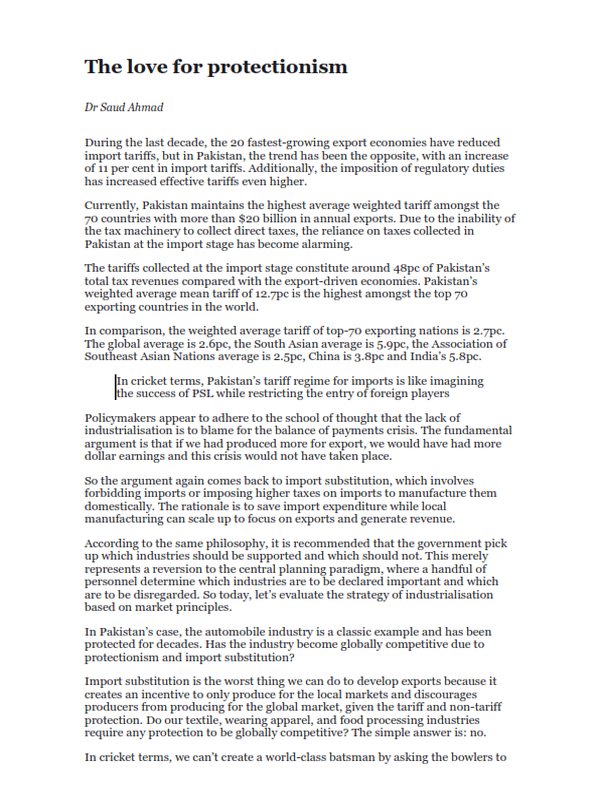The love for protectionism
During the last decade, the 20 fastest-growing export economies have reduced import tariffs, but in Pakistan, the trend has been the opposite, with an increase of 11 per cent in import tariffs. Additionally, the imposition of regulatory duties has increased effective tariffs even higher.
Currently, Pakistan maintains the highest average weighted tariff amongst the 70 countries with more than $20 billion in annual exports. Due to the inability of the tax machinery to collect direct taxes, the reliance on taxes collected in Pakistan at the import stage has become alarming.
The tariffs collected at the import stage constitute around 48pc of Pakistan’s total tax revenues compared with the export-driven economies. Pakistan’s weighted average mean tariff of 12.7pc is the highest amongst the top 70 exporting countries in the world.
In comparison, the weighted average tariff of top-70 exporting nations is 2.7pc. The global average is 2.6pc, the South Asian average is 5.9pc, the Association of Southeast Asian Nations average is 2.5pc, China is 3.8pc and India’s 5.8pc.
In cricket terms, Pakistan’s tariff regime for imports is like imagining the success of PSL while restricting the entry of foreign players
Policymakers appear to adhere to the school of thought that the lack of industrialisation is to blame for the balance of payments crisis. The fundamental argument is that if we had produced more for export, we would have had more dollar earnings and this crisis would not have taken place.
So the argument again comes back to import substitution, which involves forbidding imports or imposing higher taxes on imports to manufacture them domestically. The rationale is to save import expenditure while local manufacturing can scale up to focus on exports and generate revenue.
According to the same philosophy, it is recommended that the government pick up which industries should be supported and which should not. This merely represents a reversion to the central planning paradigm, where a handful of personnel determine which industries are to be declared important and which are to be disregarded. So today, let’s evaluate the strategy of industrialisation based on market principles.
In Pakistan’s case, the automobile industry is a classic example and has been protected for decades. Has the industry become globally competitive due to protectionism and import substitution?
Import substitution is the worst thing we can do to develop exports because it creates an incentive to only produce for the local markets and discourages producers from producing for the global market, given the tariff and non-tariff protection. Do our textile, wearing apparel, and food processing industries require any protection to be globally competitive? The simple answer is: no.
In cricket terms, we can’t create a world-class batsman by asking the bowlers to bowl loose deliveries. We can’t create a good bowler by asking the batsman to go soft on bowlers. Only in a competitive environment are heroes created. The protection is a sure way of killing the heroes and robbing poor consumers and exporters simultaneously.
That is exactly what we have been doing for the last few decades. Further, imagine the success of the Pakistan Super League if authorities restrict the entry of foreign players. Or dictate Baber Azam to bowl and Shaheen Afridi to bat. In either case, we will compromise the quality, competition, performance and misallocate the talent/resources.
No export promotion can be done through import substitution; in fact, import substitution is killing our export potential. The import duties create incentives for producers of domestic varieties of inputs at home to increase prices, as the duties deter competition from abroad.
Thus, import duties on a good tend to increase prices at home, regardless of whether the country imports that specific good or not. When the exporters have to pay more for input materials, it is impossible for even our best performing exports to be competitive in global markets. Thus the industrial policy and import substitution are contributory factors to where we are today with low exports and low productivity in the economy.
While higher tariff rates could help curb unnecessary imports, tariffs on imported raw materials could impact the country’s export performance. With the increasing importance of global value chains at different stages of production, the share of exports made up of imported inputs has also increased, and Pakistan is no exception.
Estimates suggest that around 20-30pc of imported inputs are used at different stages of production in Pakistan. Despite the importance of imported inputs in production, applied tariff rates are relatively high in Pakistan compared to its peers/competitors. The import intensity of exports is rather significant in Pakistan; high tariff rates could seriously damage the country’s export competitiveness in the international markets.
For the success of Pakistan’s trade policy to boost export performance and domestic productivity, it is more crucial than ever to reduce import tariffs and demand simplification of the tariff structure.
Pakistan’s tariff structure is complex and marked with several exemptions as well. These exemptions mostly favour large firms that curb domestic competition and provide a difficult environment for newly established or small firms to find their way up the ladder.
Protectionist policies also cause resources to be allocated towards protected industries, which results in inefficiency and suboptimal outcomes. So, there is a need to let the resources be reallocated based on free markets to ensure efficiency, productivity and export-led growth.
The writer is a research fellow at the Pakistan Institute of Development Economics
Published in Dawn, The Business and Finance Weekly, November 28th, 2022




